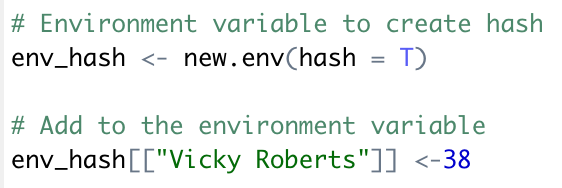Page Not Found
Page not found. Your pixels are in another canvas.
A list of all the posts and pages found on the site. For you robots out there is an XML version available for digesting as well.
Page not found. Your pixels are in another canvas.
This is a page not in th emain menu
Published:
R does not provide a native hash table structure, which is unfortunate because if you need a fast and efficient way to retrieve information without worrying about element order, the hash table is a decent data structure choice. R users are not without options, though. The first option involves using an environment variable. 
Published:
A custom tool built off of multiple python scripts was created for an in-house UX team to make it easier to create data-heavy prototypes.
Published:
In a previous blog post I introduced the concepts of standardization and normalization. A concept common to both of those techniques is distance. Simply put, distance is a mathematical summary of the differences between two objects. These objects can be data points or they can be full distributions. Distance measures fall into two categories:
Published:
UX researchers who deal with quantitative data are familiar with standardization and normalization. The reasons we would apply them in quantitative UX research are similar to why we would apply them in machine learning.
Remote Contextual Inquiry conducted in Fall 2021 with client account team members.
A draft UX research methodology for understanding how humans interact with data.
A slide deck presenting an early idea for a trust-based strategy for ML/AI product adoption.
A draft slide deck reviewing the uses of Natural Language Processing (NLP) for a UX team.
A draft guide for creating strategic narratives for AI/ML UX.
A mindmap showing a UX ResearchOps framework.
A high-level diagram showing a vision for the evolution of UX research at an employer.
Published in Prototypr.io, 2018
With the rise of A.I. in our daily lives, questions around what it means for the future of society command our attention. These questions range from inquiries into the nature of humanity, to explorations of the complex effects on economies. And lurking in the collective, a healthy sprinkle of dystopian evil robot overlord fear as a counter-balance.
Recommended citation: McFarlin, L. (2018). "Transferring Biases to A.I." Prototypr.io. https://blog.prototypr.io/transferring-biases-to-a-i-f8f36772d9e2
Published in UX Planet, 2019
Artificial Intelligence (A.I.) continues its determined march toward becoming a part of our personal lives and workdays. Sometimes its presence is negligible — it is not there until you access it, like Siri, or it runs unobtrusively, like Spotify. Other times, A.I. is a boogeyman posing a threat to our livelihoods, the intangible enemy waiting to replace us at our jobs. Does it have to be that way, though?
Recommended citation: McFarlin, L. (2019). "Positively Motivating A.I. Use in the Workplace." UX Planet. https://uxplanet.org/positively-motivating-a-i-use-in-the-workplace-8e06d82a1ab4
Published in User Experience Magazine, 2019
Build user knowledge and apply UX principles to improve user decision-making and data identification to ensure mainframe data compliance.
Recommended citation: McFarlin, L. (2019). "Supporting Mainframe Data Compliance: A UX Approach." User Experience Magazine. 19(2). https://uxpamagazine.org/supporting-mainframe-data-compliance-a-ux-approach/
Published:
As designers, technologist, and business leaders, the promise of artificial intelligence offers us a world of opportunities. At this meet-up our diverse panel of thought leaders will discuss the ethics, human interfaces, technology, and the future of AI.
Published:
The spaces in which we live, work, and play incorporate various technologies for enhancing interactions within our environments. As UX professionals, we excel at studying technology use and designing to support users, but we may only allocate a comparatively small amount of effort studying environments. However, with more spaces being designed to incorporate smart and/or immersive technologies, opportunities abound for UX professionals to collaborate with architects to understand the design and use of space.
Undergraduate course, University 1, Department, 2014
This is a description of a teaching experience. You can use markdown like any other post.
Workshop, University 1, Department, 2015
This is a description of a teaching experience. You can use markdown like any other post.